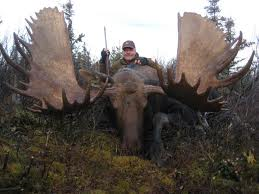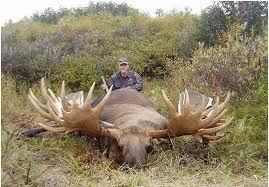africananimals.blogspot.com
Physics of the Moose
The physics of the moose when being shot can best be
explained by terminal ballistics, a sub-field of
ballistics. Moose are very large
animals so the amount of effect a bullet has on them is
less than the effect a deer would see if shot with the
same bullet. When the bullet is traveling at speeds
faster than that of sound and it strikes a
moose, the high speed and enormous energy will easily
penetrate the soft skin of the moose. The remaining
energy of the bullet continues to be transferred
to the moose as the bullet continues to penetrate. As
soon as the bullet stops penetrating the energy transfer
is complete. This concept
gives the reasoning
of an individual in bullet selection whether a lot of
penetration with a steady energy transfer is needed or
low penetration with a huge
initial blast of energy. We can look at the transfer of
energy in respect to velocity of a bullet on the average
size moose using the law of conservation of momentum. If
I am shooting a 180 grain bullet with a velocity of 2550
fps at a moose with a mass of 1400lbs, the following
will be
true:
180 grains =
0.011663804 kg
2550 fps = 777.24 m/s
1400 lbs = 1156 kg
mv = MV
goes to (0.01166kg)(777.24m/s) = (1156kg)(V)
then:
(9.0626/1156) = V and V = 0.0078396m/s = 0.0257 f/s
0.0257
fps is not a very high amount of velocity change, but
because the moose is so large this number is reasonable.
The real damage happens when the bullet expands and
begins to strike vital organs. Again there are many more
examples of physics seen by the moose, but I only chose
to show the momentum conservation between the bullet and
the moose.


